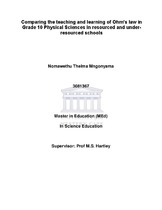| dc.contributor.advisor | Hartley, M.S. | |
| dc.contributor.author | Mngonyama, Nomawethu Thelma | |
| dc.date.accessioned | 2018-04-11T10:18:51Z | |
| dc.date.available | 2018-04-30T22:10:07Z | |
| dc.date.issued | 2018 | |
| dc.identifier.uri | http://hdl.handle.net/11394/5933 | |
| dc.description | Magister Educationis - MEd (Mathematics and Science Education) | |
| dc.description.abstract | The research study was conducted in two rural schools in the same district that served as the sample .One school is a well- resourced Dinaledi school and the other one is an under- resourced school. According to the National Diagnostic reports of the last few years, the performance of learners in the National Senior Certificate examination in Physical Sciences was poor especially in those questions that require learners' higher order thinking skills. It appeared that educators found it difficult to teach some of the topics that were based on practical work because the majority of the rural schools were underresourced. Due to the disparities and poor performance in the achievement of learners in the districts, the researcher decided to conduct this research study in an attempt to compare the teaching and learning of Ohm's law in Physical Sciences in resourced and under-resourced schools in the district. The theoretical framework that underpins this research is constructivism, as the focus is on constructing meaning and knowledge gained by the learners using apparatus such as electric circuit boards. Two classes of Grade 10 learners, one each from a resourced school and under-resourced school, were selected purposively. The classes were observed whilst being taught Ohm's law. All the learners wrote the same test and their performance was compared. The two Physical Sciences educators who taught the classes were interviewed after the lessons. The study found that in the resourced school learners were exposed to hands-on activities as part of a practical-oriented class. Their interaction with the apparatus while learning about Ohm's law put them in a much better position to answer questions, especially higher order questions. On the other hand in the under-resourced school learners were exposed to a theoretical-based teaching method which placed them at a severe disadvantage in answering questions during assessments. This study has implications for fellow science teachers, curriculum advisors and other education department officials as it describes actual practices of educators in two schools and examines the influence that resources have on learners' performances. | |
| dc.language.iso | en | |
| dc.publisher | University of the Western Cape | |
| dc.title | Comparing the teaching and learning of Ohm's law in Grade 10 Physical Sciences in resourced and underresourced schools | |
| dc.rights.holder | University of the Western Cape | |

